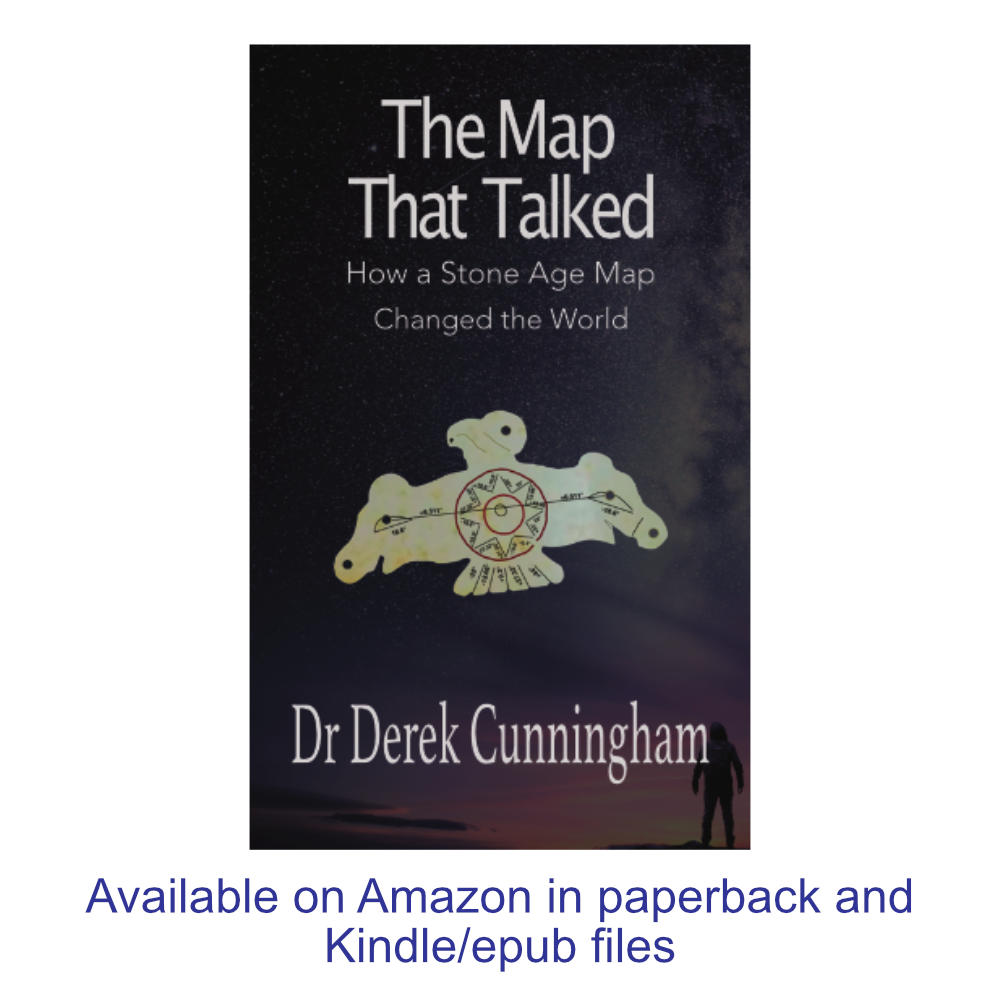Abstract – In my most recent trip to China I uncovered evidence that the Babel Text was used at the the Emei Mountian religious site, and also at the SanXingDui archaeological site, which is a four to five hours drive to the North of Emei. At the SanXingDui site the Babel Texts are linear patterns and the lines are found on an item referred to as a stool that supports a large standing humanoid figure. The patterns are found on all four sides of the stool and the all exhibits the same consistent angular array.
Introduction
The reason for visiting the SanXingDui site was to research the geometrical lines that are engraved on various artefacts. These objects, which are believed to be from the Shu Dynasty date to circa 1200 to 1100 BCE1 and thus date towards the end of the more famous Shang Dynasty2. At present only two Shu Dynasty sites are known. The Jinsha site, which was discovered in 2001, this dates from the 12th century BC until the 7th century BC, and the SanXingDui site3, which was discovered in the 1920s, but was only studied in detail after a large-scale archaeological dig in 1986 and a subsequent return to the site in the year 20211.
The major problem with studying geometrical patterns that might be religious texts in objects that date to this time period is they are often found in sites where they overlap with objects that contain abstract geometric patterns that were only designed to be artistic4.
It is thus necessary to limit these studies to the geometric patterns found in objects that appear to be linked to religion, or can be reasonably linked to the government of Shu. At the present time this limitation reduces the number of analysable patterns to just one. These being the lines found on the stool of the circa 180 cm tall standing figure that is made of bronze. This bronze figure was discovered in the 1986 survey of the No 2 pit at the SanXingDui Ruins, and it appears to mimic the general pose of a much smaller 14.6 cm tall figure that was found in 2023 in that the two statues appear to have once held a very large staff with a very large circular hole placed in their hands. The smaller of the two items is topped by a three tier “headdress”, whereas the taller item has only a two tier headdress. It should be noted that in addition to the figure which appears to be built to human scale, within the 2021 dig a giant mask (measuring 135 centimeters in width and 74 centimeters in height), was also located at the No. 3 sacrificial pit, which is so large it could not be used as an actual mask.
As stated earlier, the lines studied in this paper are present at the base of the taller statue and are found on all four sides of the square “stool” upon which the standing, bronze statue is mounted. In prior studies of this large figure, it appears that the stool has not been studied in any detail, and no prior theory has been put forward to explain either the structure of these lines, nor the enigmatic design that surrounds the lines. A video showing the statue can be seen here
Results
A preliminary analysis of these lines, quickly reveals these lines are not random and they align to the astronomical values that have recently been proven to create the basis of an archaic linear text. The worldwide presence of this ancient geometrical text is discussed in more detail in The Babel Texts, and the statistical study, which reveals that it is improbable for the lines to random in structure can be found here.
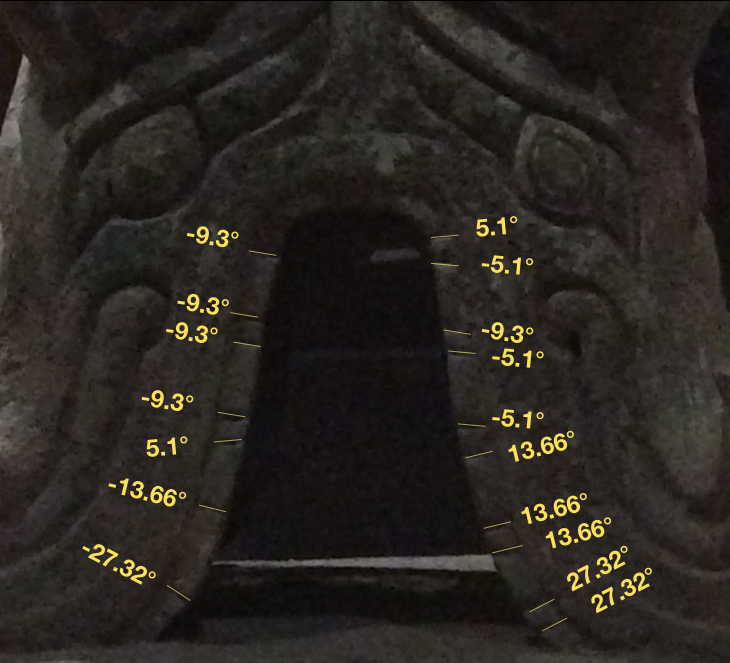
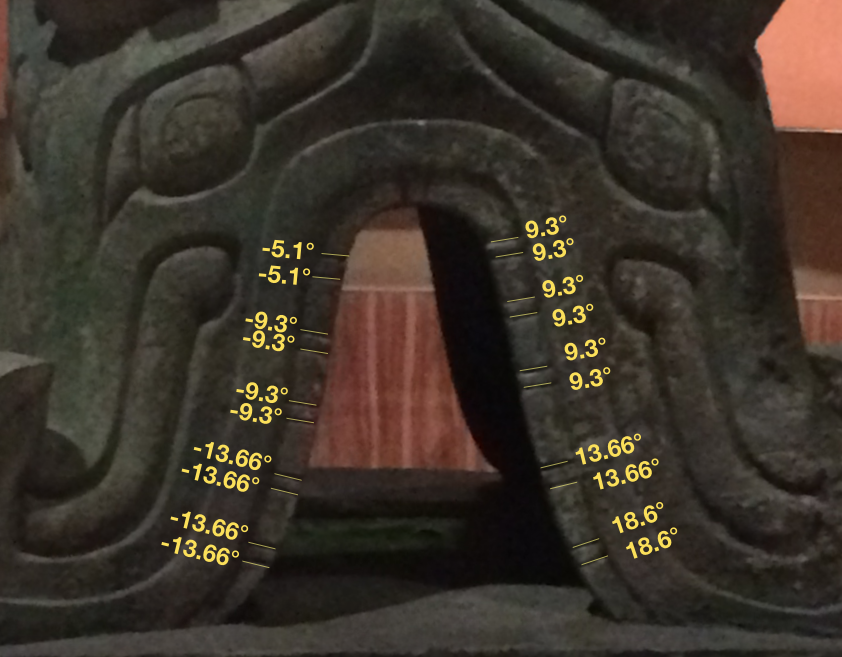
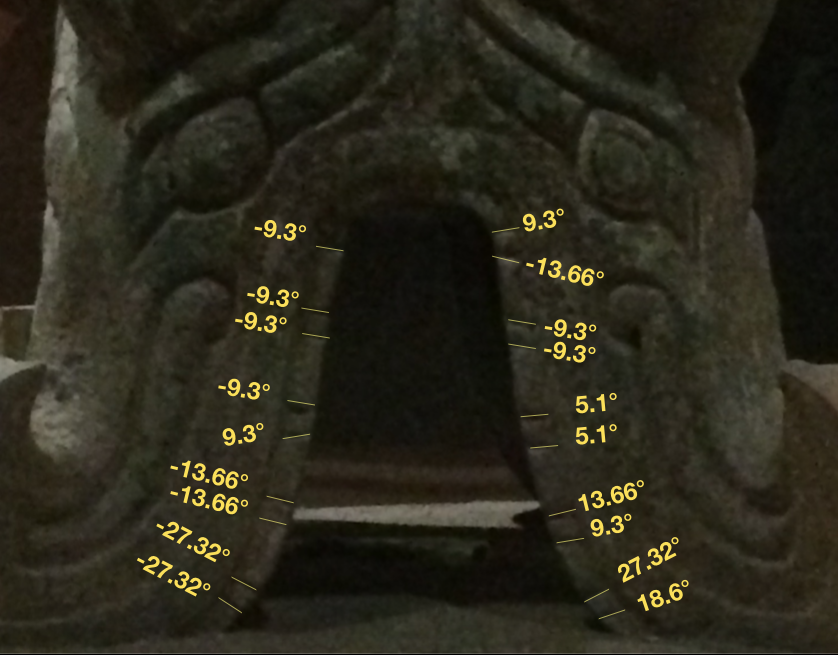
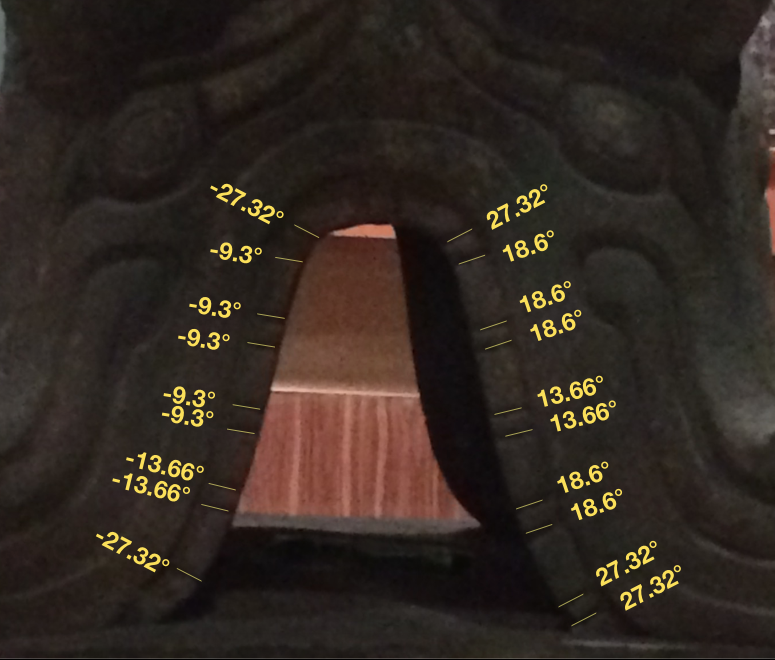
The primary result is the angles drawn by these lines overlap with the five primary peaks that are observed in a large-scale global study of this text6. In total 74 lines were analysed on this stool. Only the two lines at the top of two of the arches could not be analyzed. This was because of shadows cast by lights within the museum enclosure made it difficult to measure this group of lines accurately. The percentage of lines offset to the horizontal axis is 94.9% (this being equivalent to 74 out of 78 lines), and 5.1% of the lines (4 lines out of 78) are aligned as offsets to the vertical.
Amongst the studied lines 11 lines were found to overlap with an alignment close to 27.32 degrees, and 18 lines align to its half value at 13.66 degrees. There are 7 lines aligned to 18.6 degrees and 29 lines aligned to its half value at 9.3 degrees. Again, all lines inthis specific study are aligned to either above or below the horizontal. Finally, there are 9 lines aligned to 5.1 degrees. In total there were 17 lines studied on side 1, 20 lines on side 2, 19 lines on side 3 and 19 lines on side 4.

A comparison between data taken from all previously studied linear geometric texts, in which the orientation of the geometrical image is fixed and cannot be rotated4,5, and the data extracted from the SanXingDui “stool” is shown below, and as can be seen there is perfect overlap between the two datasets, with the same five primary lines appearing in both graphs.
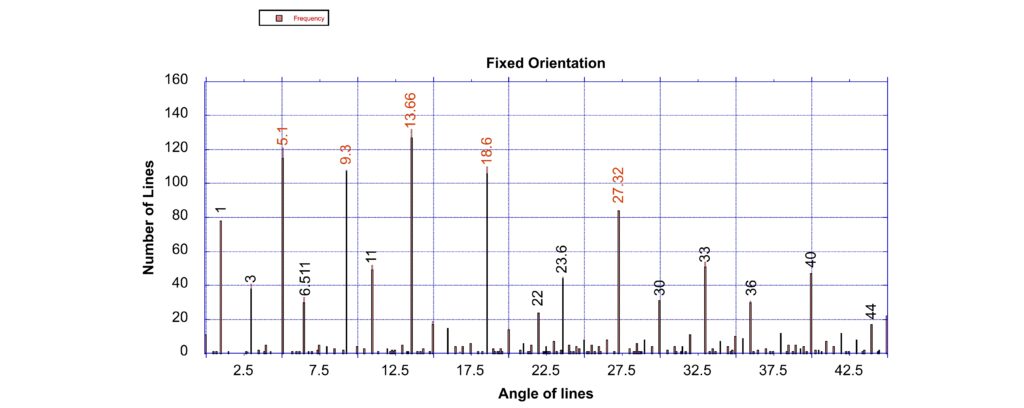
From statistics, the probability for this overlap to occur by chance is 1 in 1,221,759 (this being calculated from 45C5, with each line assumed to have an error of ± 0.5 degrees.
In addition with the lines being offset by up to 45 degrees to above and below the horizontal this creates a mirror plane, and the probability for these lines being random reduces to 1 in 1,492,695,054,081. For comparison, in medical trials, a p-value of 0.05, which is equivalent to a 1 in 20 chance, is the standard value that is considered to mark a clinical trial as being statistically significant.
For completeness, the statistical probability for this study of the SanXingDui stool to emphasise the exact same five angles as the large scale world-wide study6 and a world-wide study on mobile art6 is 1 in 3.27 x 1051. This is equivalent to a p-value of 3.054 x 10-52.
As can be seen the value in this specific test is well below the boundary that is considered to mark a result as being statistically significant.
Thus, because it is now very unlikely that these lines were aligned to these specific angles by chance, this then argues the lines were drawn with intent. In addition, as can be seen four of the lines are consistent with just two astronomical values, the 27.32-day sidereal month and the 18.6-year luna cycle. The line at circa 5 degrees is believed to relate to the angle of the moon’s orbital plane relative to Earth.
These specific values are important in astronomical studies, as the half and full values of the sidereal month identify when moonrise and the setting of the moon will transitions from being in the north to the south. The sidereal month is also used by astronomers to measure the duration of the year, and from its 366 cycle each year this lunar term can be used to determine that the Earth takes 365 days to rotate around the sun, even without the use of a clock. To understand this visually, there are many interesting videos that describe the so-called penny paradox, where a penny will take two complete rotations to rotate around another penny of the same size (see here).
So, in conclusion the angular geometrics found on this specific bronze figure shows good agreement with the Babel Texts4,5, but further work is still required to determine if the same trend is found on other linear geometric patterns that have been uncovered from the same pit at the SanXingDui site. As previously stated, care is required in studying the archaeological finds that are circa 3,000 years old. This is because within this era the use of the Babel Text in religious figures does overlap with the creation of geometric art and the use of non-angular texts within China.
Thus, in order to confirm that the geometrical text was used widely in the Shu Dynasty more SanXingDui samples will need to be recovered that show consistent angles. If this is achieved, this would confirm the Shu dynasty were literate, and it would also argue the belief system in Shu was different from the belief system that was then being worshipped in the Shang Dynasty. Within the Shang Dynasty Oracle Bones, which date to the same general time period, the symbols are usually more cursive.
As always, more work is required.
References
- Zhao Hao, 2023 Sammy Yukuan Lee Lectures on Chinese Art and Archaeology, UCLA Center for Chinese Studies
- Selena Lai and Waka Takahashi Brown, Stanford Program on International and Cross-Cultural Education, Excerpt from Chinese Dynasties Part One: The Shang Dynasty Through the Tang Dynasty, 1600 BCE to 907 CE
- Jinsha Site Museum, online information about the history of the site.
- Derek Cunningham, The Babel Texts, Amazon Books.
- Derek Cunningham, The Map That Talked, Amazon Books
- Derek Cunningham, New Study Reveals Stone Age People Could Read – and were Homo sapiens the first species to learn to write?, The Babel Texts Research Papers Vol. 1, Feb 25, 2024.


